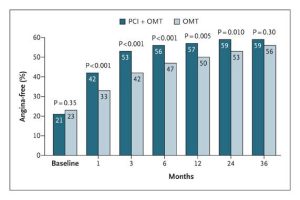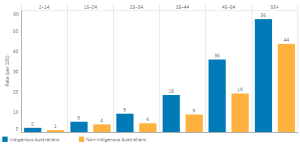3.7 Prevalence of and Risk Factors for Stable Angina
John Smithson
Incidence of Angina in Australia
Angina pectoris, a common manifestation of coronary artery disease (CAD), affects a significant portion of the population. Approximately 29% of patients with stable angina experience symptoms at least once a week. Effective management of angina often involves a combination of optimal medical therapy (OMT) and percutaneous coronary intervention (PCI). Studies indicate that patients receiving both OMT and PCI have a higher likelihood of remaining angina-free compared to those on OMT alone (Weintraub et al., 2008).

OMT denotes optimal medical therapy, and PCI percutaneous coronary intervention.
In Australia, an estimated 580,000 adults (3.1% of the population) have experienced coronary heart disease (CHD) at some point, with 227,000 reporting episodes of angina. The incidence of stable angina is notable, with over 72,000 hospital admissions in 2018 alone. Angina rates are higher in males compared to females and increase with age. Furthermore, Indigenous Australians are disproportionately affected, with 16% of Aboriginal and Torres Strait Islander people aged 2 and over reporting cardiovascular disease, including angina. The prevalence of cardiovascular disease is notably higher in remote Indigenous communities (18%) compared to non-remote areas (15%) (AIHW and ABS analysis).

Note in the figure above, the incidence of CVD increases with age and across all age groups, the incidence of CVD (including angina) is higher for Indigenous Australians (in blue) compared with non-Indigenous Australians (in yellow).
Risk factors for Angina
Angina pectoris risk factors are categorized into modifiable and non-modifiable types.
David has these risk factors for developing angina:
- Poorly Controlled Hypertension: David’s history of hypertension that is not well managed increases the risk of coronary artery disease, which can lead to angina.
- Age: David is 54 years old, and the risk for angina increases with age.
- Hyperlipidemia: High cholesterol levels contribute to the development of atherosclerosis, increasing the risk of angina.
- Lifestyle Factors: Factors such as smoking, sedentary lifestyle, and obesity, if present, would further increase the risk for angina. David may have none of these though his BMI is 27, suggesting he is a little overweight.
📺 Watch the vodcast on the Incidence of Stable Angina. (5:08 minutes)
Try the following questions to reinforce your learning.
COMMONWEALTH OF AUSTRALIA Copyright Regulations 1969 WARNING
This material has been reproduced and communicated to you by or on behalf of James Cook University in accordance with section 113P of the Copyright Act 1969 (Act).
The material in this communication may be subject to copyright under the Act. Any further reproduction or communication of this material by you may be the subject of copyright protection under the Act. Do not remove this notice.
